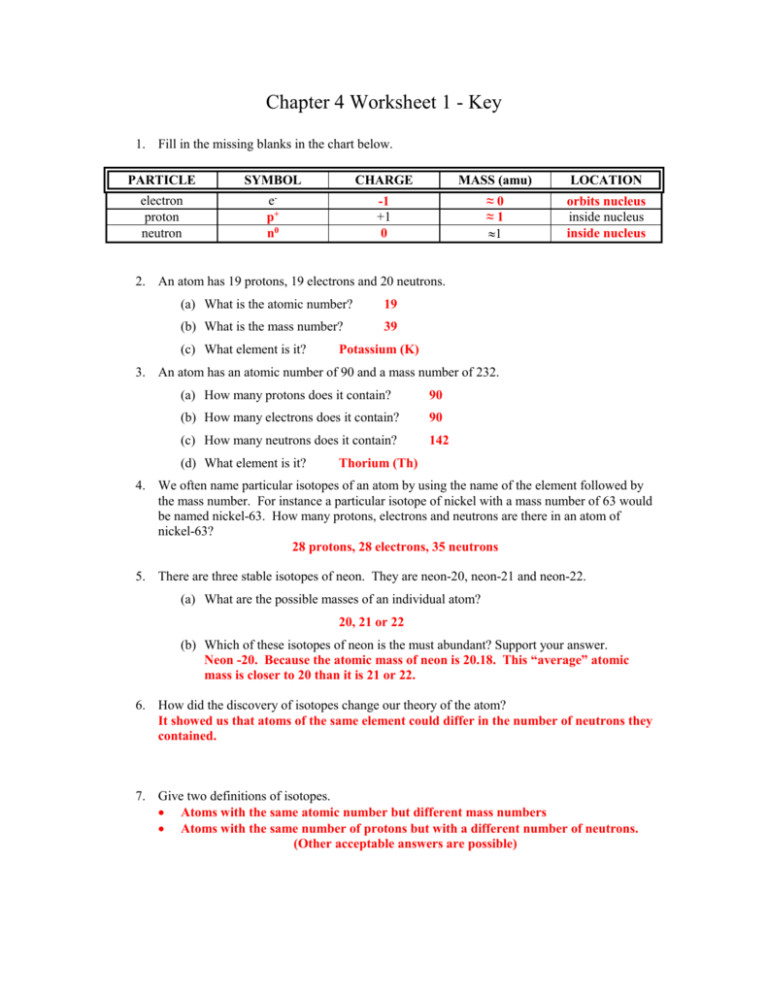Chapter 4 Worksheet 1
advertisement

Chapter 4 Worksheet 1 - Key 1. Fill in the missing blanks in the chart below. PARTICLE electron proton neutron SYMBOL - e p+ n0 CHARGE MASS (amu) LOCATION -1 +1 0 ≈0 ≈1 1 orbits nucleus inside nucleus inside nucleus 2. An atom has 19 protons, 19 electrons and 20 neutrons. (a) What is the atomic number? 19 (b) What is the mass number? 39 (c) What element is it? Potassium (K) 3. An atom has an atomic number of 90 and a mass number of 232. (a) How many protons does it contain? 90 (b) How many electrons does it contain? 90 (c) How many neutrons does it contain? 142 (d) What element is it? Thorium (Th) 4. We often name particular isotopes of an atom by using the name of the element followed by the mass number. For instance a particular isotope of nickel with a mass number of 63 would be named nickel-63. How many protons, electrons and neutrons are there in an atom of nickel-63? 28 protons, 28 electrons, 35 neutrons 5. There are three stable isotopes of neon. They are neon-20, neon-21 and neon-22. (a) What are the possible masses of an individual atom? 20, 21 or 22 (b) Which of these isotopes of neon is the must abundant? Support your answer. Neon -20. Because the atomic mass of neon is 20.18. This “average” atomic mass is closer to 20 than it is 21 or 22. 6. How did the discovery of isotopes change our theory of the atom? It showed us that atoms of the same element could differ in the number of neutrons they contained. 7. Give two definitions of isotopes. Atoms with the same atomic number but different mass numbers Atoms with the same number of protons but with a different number of neutrons. (Other acceptable answers are possible) 8. Define the term “atom” An atom is the smallest particle of an element that retains that element’s properties. 9. Matching: _I_ Democritus A. discovered the nucleus _E_ Aristotle B. proposed the first scientifically supported atomic theory _F_ Francis Bacon C. father of modern chemistry, disproved phlogiston theory _H_ Robert Boyle D. discovered the electron and isotopes _C_ Antoine Lavoisier _B_ John Dalton E. believed in the four elements and proposed aither F. father of inductive reasoning, “Knowledge is Power” _A_ Ernest Rutherford G. discovered the neutron _D_ J. J. Thomson H. first modern chemist _G_ James Chadwick I. first proposed that matter was made of atoms 10. Explain why J.J. Thomson’s discovery of the electron required the idea of what an atom was to change? It was assumed that an atom could not be broken down into anything smaller. J.J. Thomson’s discovery of the electron changed our understanding of the atom to include subatomic particles which make up atoms. 11. What was the design of Ernest Rutherford’s “Gold Foil Experiment”? Rutherford fired positively charged alpha particles at a very thin sheet of gold foil. Most of the particles went through the gold foil but a few were deflected. 12. How did Ernest Rutherford’s “Gold Foil Experiment change our view of the atom? It indicated that the atom had a very small central core that was very dense and positively charged. He called it the nucleus. The electrons orbited this nucleus. 13. Define “atomic mass”. Atomic mass is the average mass of all the isotopes of an atom. It takes into account the different isotopes of an element and their relative abundance. 14. The nucleus of all gold atoms must have one thing in common. What is it? All gold atoms have 79 protons in their nucleus. 15. State two uses of isotopes. Radiometric Dating Magnetic Resonance Imaging (MRI) Positron Emission Tomography (PET scans) Isotope Analysis 16. What is the average atomic mass for boron, B? The natural abundance for boron isotopes is: 19.9% 10B with a mass of 10.013 amu and and 80.1% 11B with a mass of 11.009 amu. Calculate the atomic mass of boron. [(0.199)(10.013 amu)] + [(0.801)(11.009 amu)] = [1.99] + [8.81] = 10.8 so, the atomic weight of B = 10.8 amu







